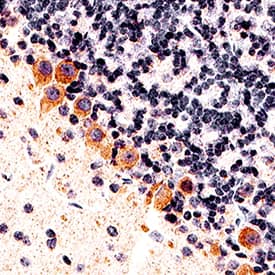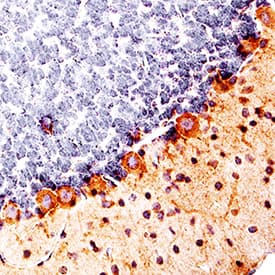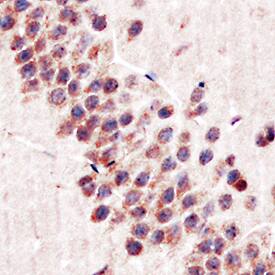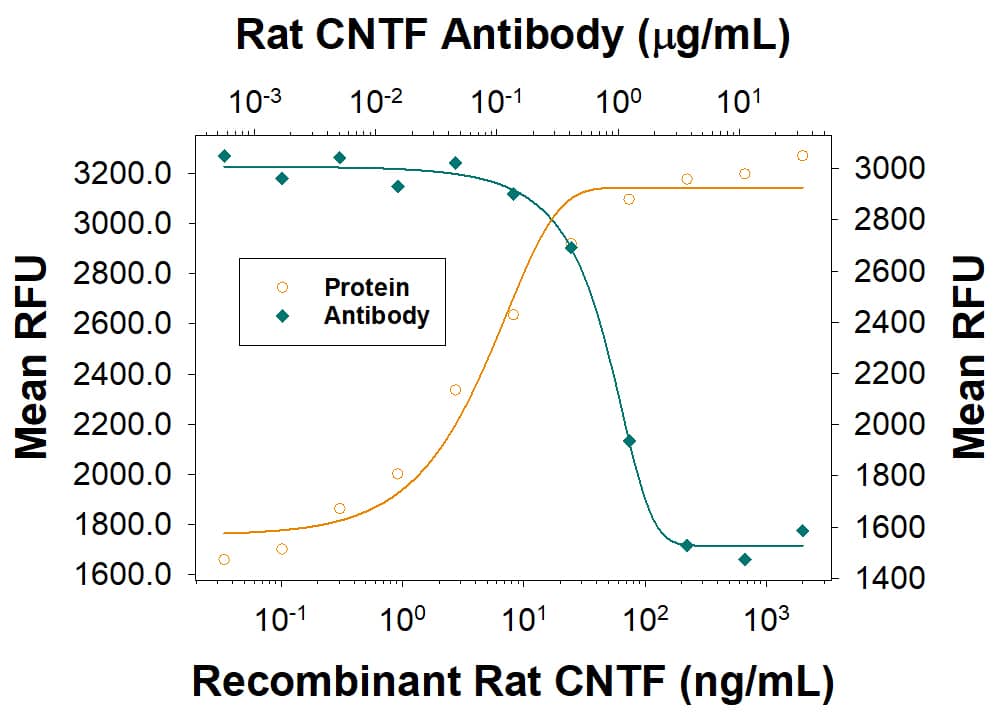Mouse/Rat CNTF Antibody Summary
Ala2-Met200
Accession # P20294.1
Applications
Please Note: Optimal dilutions should be determined by each laboratory for each application. General Protocols are available in the Technical Information section on our website.
Scientific Data
 View Larger
View Larger
CNTF in Mouse Cerebellum. CNTF was detected in perfusion fixed frozen sections of mouse cerebellum using Goat Anti-Rat CNTF Antigen Affinity-purified Polyclonal Antibody (Catalog # AF-557-NA) at 1.7 µg/mL for 1 hour at room temperature followed by incubation with the Anti-Goat IgG VisUCyte™ HRP Polymer Antibody (Catalog # VC004). Tissue was stained using DAB (brown) and counterstained with hematoxylin (blue). Specific staining was localized to Purkinje neurons. View our protocol for IHC Staining with VisUCyte HRP Polymer Detection Reagents.
 View Larger
View Larger
CNTF in Rat Cerebellum. CNTF was detected in perfusion fixed frozen sections of rat cerebellum using Goat Anti-Rat CNTF Antigen Affinity-purified Polyclonal Antibody (Catalog # AF-557-NA) at 5 µg/mL for 1 hour at room temperature followed by incubation with the Anti-Goat IgG VisUCyte™ HRP Polymer Antibody (Catalog # VC004). Tissue was stained using DAB (brown) and counterstained with hematoxylin (blue). Specific staining was localized to Purkinje neurons. View our protocol for IHC Staining with VisUCyte HRP Polymer Detection Reagents.
 View Larger
View Larger
CNTF in Mouse Brain. CNTF was detected in perfusion fixed paraffin-embedded sections of mouse brain (hippocampus) using Goat Anti-Rat CNTF Antigen Affinity-purified Polyclonal Antibody (Catalog # AF-557-NA) at 5 µg/mL for 1 hour at room temperature followed by incubation with the Anti-Goat IgG VisUCyte™ HRP Polymer Antibody (Catalog # VC004). Before incubation with the primary antibody, tissue was subjected to heat-induced epitope retrieval using Antigen Retrieval Reagent-Basic (Catalog # CTS013). Tissue was stained using DAB (brown) and counterstained with hematoxylin (blue). Specific staining was localized to cell membranes and cytoplasm of Purkinje cells. View our protocol for IHC Staining with VisUCyte HRP Polymer Detection Reagents.
 View Larger
View Larger
Cell Proliferation Induced by CNTF and Neutralization by Rat CNTF Antibody. Recom-binant Rat CNTF (Catalog # 557-NT) stimulates proliferation in the TF-1 human erythro-leukemic cell line in a dose-dependent manner (orange line). Proliferation elicited by Recombinant Rat CNTF (20 ng/mL) is neutralized (green line) by increasing concentrations of Goat Anti-Rat CNTF Antigen Affinity-purified Polyclonal Antibody (Catalog # AF-557-NA). The ND50 is typ-ically 0.3-2.4 µg/mL.
Preparation and Storage
- 12 months from date of receipt, -20 to -70 °C as supplied.
- 1 month, 2 to 8 °C under sterile conditions after reconstitution.
- 6 months, -20 to -70 °C under sterile conditions after reconstitution.
Background: CNTF
Ciliary neurotrophic factor (CNTF) is a polypeptide initially purified from chick embryo ocular tissue and identified as a trophic factor for embryonic chick ciliary parasympathetic neurons in culture. Subsequent studies have demonstrated that CNTF is a survival factor for additional neuronal cell types including: dorsal root ganglion sensory neurons, sympathetic ganglion neurons, embryonic motor neurons, major pelvic ganglion neurons, and hippocampal neurons. CNTF has also been shown to prevent the degeneration of motor axons after axotomy. The cDNA for CNTF encodes a 200 amino acid residue polypeptide that lacks a signal sequence. CNTF is highly conserved across species and exhibits cross-species activities. Human and rat CNTF share approximately 83% homology in their protein sequence. CNTF is structurally related to IL-6, IL-11, LIF, and OSM. All of these four helix bundle cytokines share gp130 as a signal-transducing subunit in their receptor complexes.
Product Datasheets
Citations for Mouse/Rat CNTF Antibody
R&D Systems personnel manually curate a database that contains references using R&D Systems products. The data collected includes not only links to publications in PubMed, but also provides information about sample types, species, and experimental conditions.
12
Citations: Showing 1 - 10
Filter your results:
Filter by:
-
LZK-dependent stimulation of astrocyte reactivity promotes corticospinal axon sprouting
Authors: Meifan Chen, Laura Ingle, Erik J. Plautz, Xiangmei Kong, Rui Tang, Neil Ghosh et al.
Frontiers in Cellular Neuroscience
-
Action of Administered Ciliary Neurotrophic Factor on the Mouse Dorsal Vagal Complex
Authors: Martina Senzacqua, Ilenia Severi, Jessica Perugini, Samantha Acciarini, Saverio Cinti, Antonio Giordano
Frontiers in Neuroscience
-
The astrocytic TRPA1 channel mediates an intrinsic protective response to vascular cognitive impairment via LIF production
Authors: Kakae, M;Nakajima, H;Tobori, S;Kawashita, A;Miyanohara, J;Morishima, M;Nagayasu, K;Nakagawa, T;Shigetomi, E;Koizumi, S;Mori, Y;Kaneko, S;Shirakawa, H;
Science advances
Species: Mouse, Transgenic Mouse
Sample Types: Whole Tissue
Applications: Immunohistochemistry -
The Rare IL22RA2 Signal Peptide Coding Variant rs28385692 Decreases Secretion of IL-22BP Isoform-1, -2 and -3 and Is Associated with Risk for Multiple Sclerosis
Authors: P Gómez-Fern, A Lopez de L, I Astobiza, J Mena, A Urtasun, V Altmann, F Matesanz, D Otaegui, E Urcelay, A Antigüedad, S Malhotra, X Montalban, T Castillo-T, L Espino-Pai, O Aktas, M Buttmann, A Chan, B Fontaine, PA Gourraud, M Hecker, S Hoffjan, C Kubisch, T Kümpfel, F Luessi, UK Zettl, F Zipp, I Alloza, M Comabella, CM Lill, K Vandenbroe
Cells, 2020-01-10;9(1):.
Species: Mouse
Sample Types: Cell Lysate
Applications: Western Blot -
Therapeutic Potential of AAV1-Rheb(S16H) Transduction Against Alzheimer's Disease
Authors: GJ Moon, S Kim, MT Jeon, KJ Lee, IS Jang, M Nakamura, SR Kim
J Clin Med, 2019-11-22;8(12):.
Species: Mouse
Sample Types: Whole Tissue
Applications: IHC -
Opposite effects of a high-fat diet and calorie restriction on ciliary neurotrophic factor signaling in the mouse hypothalamus.
Authors: Severi I, Perugini J, Mondini E, Smorlesi A, Frontini A, Cinti S, Giordano A
Front Neurosci, 2013-12-27;7(0):263.
Species: Mouse
Sample Types: Whole Tissue
Applications: IHC -
AAV-mediated expression of CNTF promotes long-term survival and regeneration of adult rat retinal ganglion cells.
Authors: Leaver SG, Cui Q, Plant GW, Arulpragasam A, Hisheh S, Verhaagen J, Harvey AR
Gene Ther., 2006-05-18;13(18):1328-41.
Species: Mouse
Sample Types: Whole Tissue
Applications: IHC -
Cardiotrophin-1 in choroid plexus and the cerebrospinal fluid circulatory system.
Authors: Gard AL, Gavin E, Solodushko V, Pennica D
Neuroscience, 2004-01-01;127(1):43-52.
Species: Mouse, Rat
Sample Types: Tissue Homogenates
Applications: Western Blot -
Inhibition of the Jak-STAT pathway prevents CNTF-mediated survival of axotomized oxytocinergic magnocellular neurons in organotypic cultures of the rat supraoptic nucleus
Authors: Jason M. Askvig, David Y. Lo, Adam W. Sudbeck, Kathryn E. Behm, Laura J. Leiphon, John A. Watt
Experimental Neurology
-
Restoration of skilled locomotion by sprouting corticospinal axons induced by co-deletion of PTEN and SOCS3
Authors: Duo Jin, Yuanyuan Liu, Fang Sun, Xuhua Wang, Xuefeng Liu, Zhigang He
Nature Communications
-
Hypothalamic CNTF volume transmission shapes cortical noradrenergic excitability upon acute stress
Authors: Alán Alpár, Péter Zahola, János Hanics, Zsófia Hevesi, Solomiia Korchynska, Marco Benevento et al.
The EMBO Journal
-
Neuronal activity and axonal sprouting differentially regulate CNTF and CNTF receptor complex in the rat supraoptic nucleus
Authors: Jason M. Askvig, Laura J. Leiphon, John A. Watt
Experimental Neurology
FAQs
No product specific FAQs exist for this product, however you may
View all Antibody FAQsReviews for Mouse/Rat CNTF Antibody
There are currently no reviews for this product. Be the first to review Mouse/Rat CNTF Antibody and earn rewards!
Have you used Mouse/Rat CNTF Antibody?
Submit a review and receive an Amazon gift card.
$25/€18/£15/$25CAN/¥75 Yuan/¥2500 Yen for a review with an image
$10/€7/£6/$10 CAD/¥70 Yuan/¥1110 Yen for a review without an image

